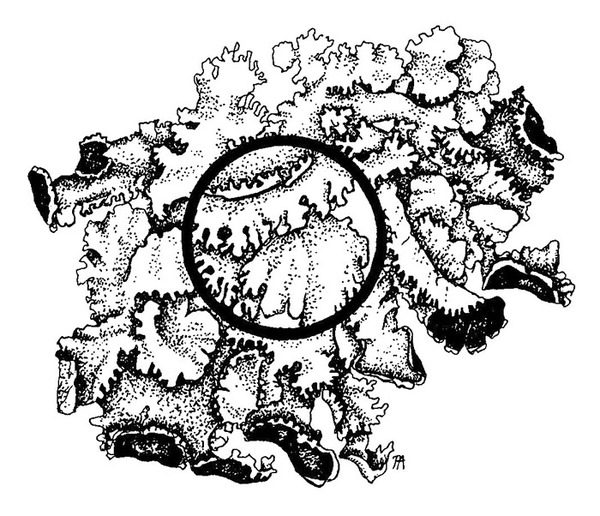Nephroma helveticum Ach.
Lichenogr. Univ.: 532, 1810.
Synonyms:
Distribution: N - TAA (Nascimbene & Caniglia 2000, Timdal & al. 2021), Lomb (Timdal & al. 2021), Piem (Morisi & Sereno 1995, Piervittori 2003).
Description: Thallus foliose, heteromerous, dorsiventral, loosely adnate, crisp, 0.15-0.20 mm thick, forming 3-4(-8) cm wide, regular to irregular rosettes. Lobes 2-5 mm wide, elongate, with subrotund apices, the margins frequently toothed, the fertile lobes with sharp teeth measuring 0.6-1 x c. 0.1 mm. Upper surface grey-brown to dark brown when dry, much darker when wet, smooth, finely pubescent, isidiate-phyllidiate, the isidia at first cylindrical, then flattened, 0.1-0.2 mm in diam., mostly marginal but later expanding on the upper surface. Lower surface dark brown to black, paler at margins, pubescent or tomentose, not papillate. Upper and lower cortex paraplectenchymatous; medulla white. Apothecia common, immersed on lower surface at tips of lobes, up to 8 mm across, cup-shaped, sessile, with a brown disc, emarginate, the dorsal surface rough and tomentose. Epithecium brownish; hymenium and hypothecium colourless. Asci 8-spored, fissitunicate, the thickened apex with a K/I+ blue ring, Peltigera-type. Ascospores 3-septate, pale brown, subfusiform, thick-walled, most of them 21-27 x 6-8 μm. Pycnidia black, mainly marginal, immersed, punctiform, Conidia bacilliform, 3-4 x 1-2 µm. Photobiont cyanobacterial (Nostoc, the cells not in long chains). Spot tests: upper cortex K-, C-, KC-, P-; medulla K+ pale yellow or K-, C-, KC-, P-. Chemistry: upper cortex with an unknown brown pigment; medulla with 7/β-acetoxyhopan-22-ol (Tl) (±), and hopane-7β,22-diol, plus unknown UV+ substances.Note: a cool-temperate to southern boreal-montane, circumpolar lichen found on bark, exceptionally on siliceous rocks in humid, but somehow subcontinental upland areas; probably more widespread in the Alps, but never common, and strongly declining. The Italian material should be checked against the very similar N. tropicum, which also occurs in Italy (see Timdal & al. 2021). Earlier records for Venezia Giulia and Tuscany refer to N. resupinatum, that from Veneto to N. tropicum. It is included in the Italian red list of epiphytic lichens as “Vulnerable” (Nascimbene & al. 2013c).
Growth form: Foliose, broad lobed
Substrata: bark
Photobiont: cyanobacteria, filamentous (e.g. Nostoc, Scytonema)
Reproductive strategy: mainly asexual, by isidia, or isidia-like structures (e.g. schizidia)
Commonnes-rarity: (info)
Alpine belt: absent
Subalpine belt: extremely rare
Oromediterranean belt: absent
Montane belt: very rare
Submediterranean belt: absent
Padanian area: absent
Humid submediterranean belt: absent
Humid mediterranean belt: absent
Dry mediterranean belt: absent

Predictive model
Herbarium samples

Source: Timdal, E., Hofton, T. H., Westberg, M. & Bendiksby, M. 2021. The Nephroma helveticum complex (Peltigerales, lichenized Ascomycota) in the Nordic countries. Graphis Scripta 33 (6): 86–110. Oslo. ISSN 2002-4495. - CC BY-4.0
Nephroma helveticum, Norway, Hofton 19181 (O L-226836).
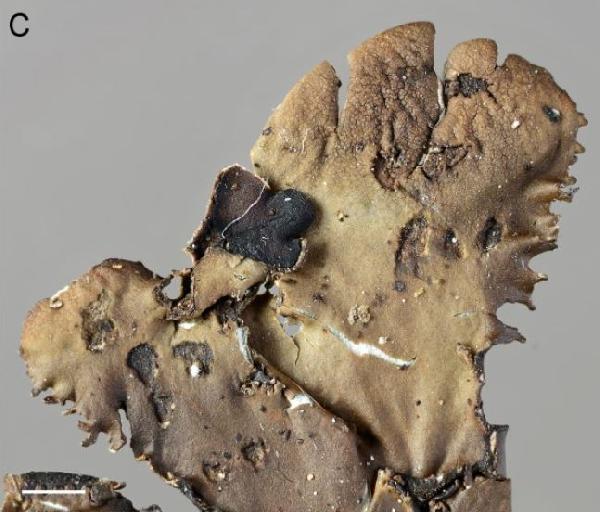
Source: Timdal, E., Hofton, T. H., Westberg, M. & Bendiksby, M. 2021. The Nephroma helveticum complex (Peltigerales, lichenized Ascomycota) in the Nordic countries. Graphis Scripta 33 (6): 86–110. Oslo. ISSN 2002-4495. - CC BY-4.0
Nephroma helveticum, Norway, Hofton 19181 (O L-226836).
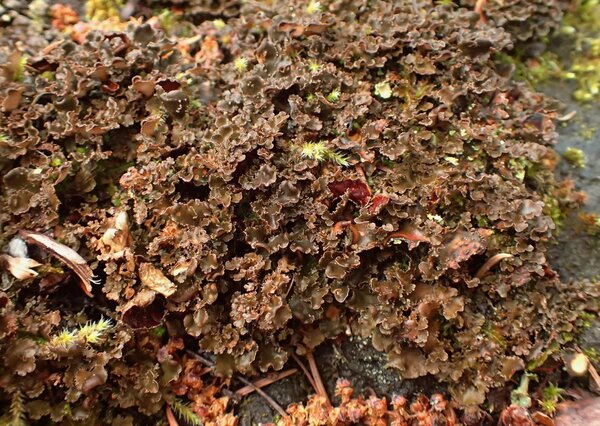

Curtis Randall Björk, - CC BY-SA 4.0
British Columbia, Canada, first western range of the Rocky Mountains over the Robson Valley, British Columbia, Canada
2018
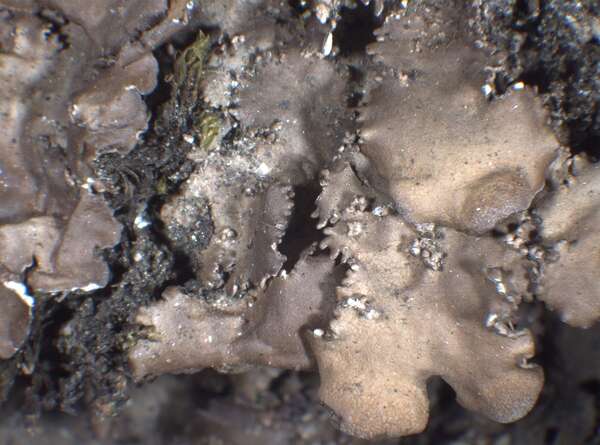

P.L. Nimis; Owner: Department of Life Sciences, University of Trieste
Herbarium: TSB (27254)
2003/03/12
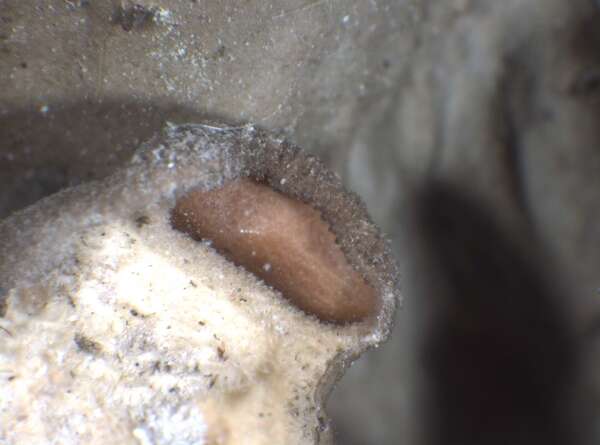

P.L. Nimis; Owner: Department of Life Sciences, University of Trieste
Herbarium: TSB (34253)
2003/03/12
apothecium
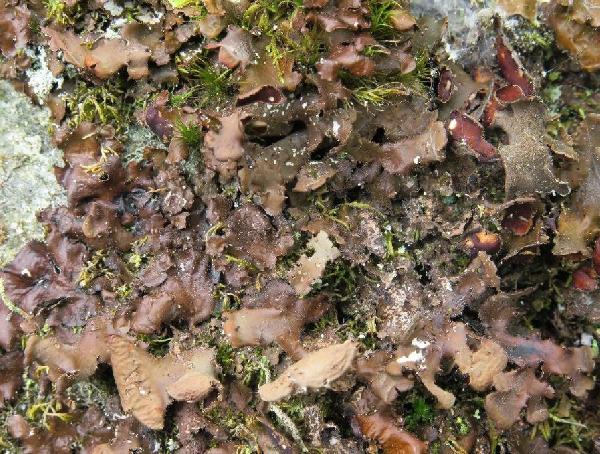
Source: Timdal, E., Hofton, T. H., Westberg, M. & Bendiksby, M. 2021. The Nephroma helveticum complex (Peltigerales, lichenized Ascomycota) in the Nordic countries. Graphis Scripta 33 (6): 86–110. Oslo. ISSN 2002-4495. - CC BY-4.0
Nephroma helveticum. Field photograph at Ulaåsen (Norway, Buskerud). Photo T. H. Hofton.
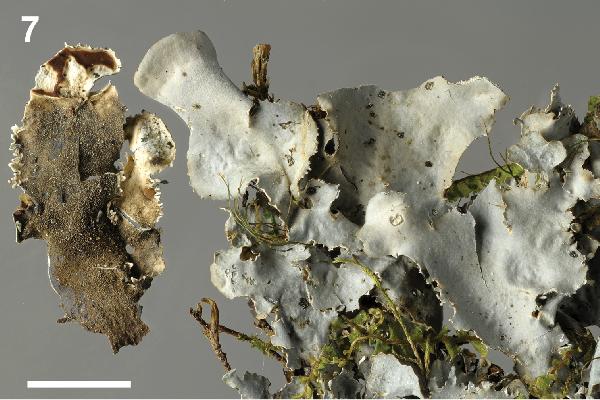
Source: Westberg M, Timdal E, Asplund J, Bendiksby M, Haugan R, Jonsson F, Larsson P, Odelvik G, Wedin M, Millanes AM (2015) New records of lichenized and lichenicolous fungi in Scandinavia. MycoKeys 11: 33-61. - CC BY-4.0
NORWAY. Buskerud: Nes municipality, Gardnosberget, MGRS: 32V NN 0230, 2309, alt. 300 m, east-facing, steep slope below high mountain wall, open spruce forest over rock field, on boulder. 10 September 2013, Hofton 13176 (O L-196491), TLC: series of terpenoids, including T4 (major).
Scale: 5 mm
Growth form: Foliose, broad lobed
Substrata: bark
Photobiont: cyanobacteria, filamentous (e.g. Nostoc, Scytonema)
Reproductive strategy: mainly asexual, by isidia, or isidia-like structures (e.g. schizidia)
Commonnes-rarity: (info)
Alpine belt: absent
Subalpine belt: extremely rare
Oromediterranean belt: absent
Montane belt: very rare
Submediterranean belt: absent
Padanian area: absent
Humid submediterranean belt: absent
Humid mediterranean belt: absent
Dry mediterranean belt: absent

Predictive model
| Herbarium samples |

Source: Timdal, E., Hofton, T. H., Westberg, M. & Bendiksby, M. 2021. The Nephroma helveticum complex (Peltigerales, lichenized Ascomycota) in the Nordic countries. Graphis Scripta 33 (6): 86–110. Oslo. ISSN 2002-4495. - CC BY-4.0
Nephroma helveticum, Norway, Hofton 19181 (O L-226836).

Source: Timdal, E., Hofton, T. H., Westberg, M. & Bendiksby, M. 2021. The Nephroma helveticum complex (Peltigerales, lichenized Ascomycota) in the Nordic countries. Graphis Scripta 33 (6): 86–110. Oslo. ISSN 2002-4495. - CC BY-4.0
Nephroma helveticum, Norway, Hofton 19181 (O L-226836).


Curtis Randall Björk, - CC BY-SA 4.0
British Columbia, Canada, first western range of the Rocky Mountains over the Robson Valley, British Columbia, Canada
2018


P.L. Nimis; Owner: Department of Life Sciences, University of Trieste
Herbarium: TSB (27254)
2003/03/12


P.L. Nimis; Owner: Department of Life Sciences, University of Trieste
Herbarium: TSB (34253)
2003/03/12
apothecium

Source: Timdal, E., Hofton, T. H., Westberg, M. & Bendiksby, M. 2021. The Nephroma helveticum complex (Peltigerales, lichenized Ascomycota) in the Nordic countries. Graphis Scripta 33 (6): 86–110. Oslo. ISSN 2002-4495. - CC BY-4.0
Nephroma helveticum. Field photograph at Ulaåsen (Norway, Buskerud). Photo T. H. Hofton.

 INDEX FUNGORUM
INDEX FUNGORUM
 GBIF
GBIF
 DOLICHENS
DOLICHENS
